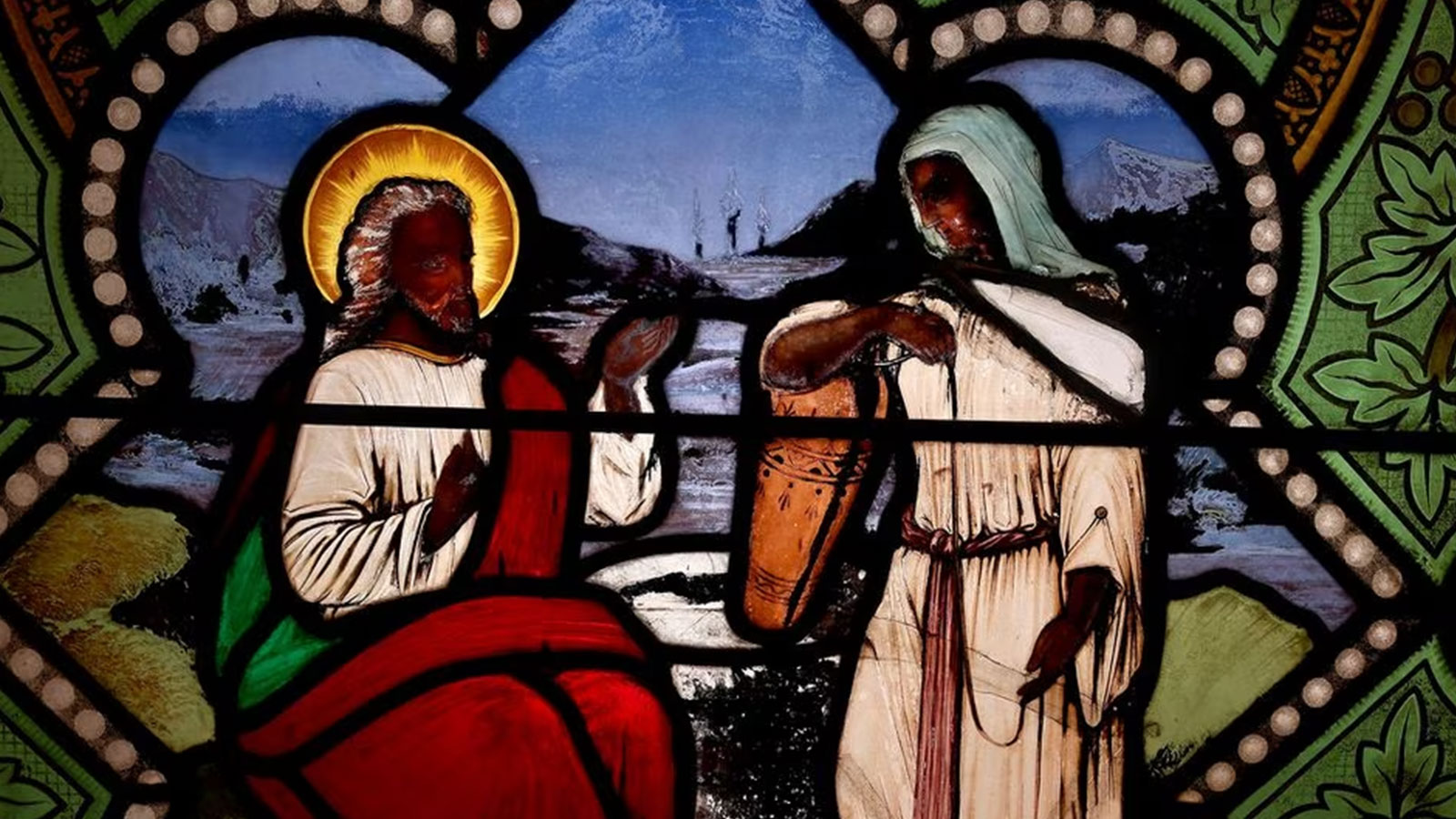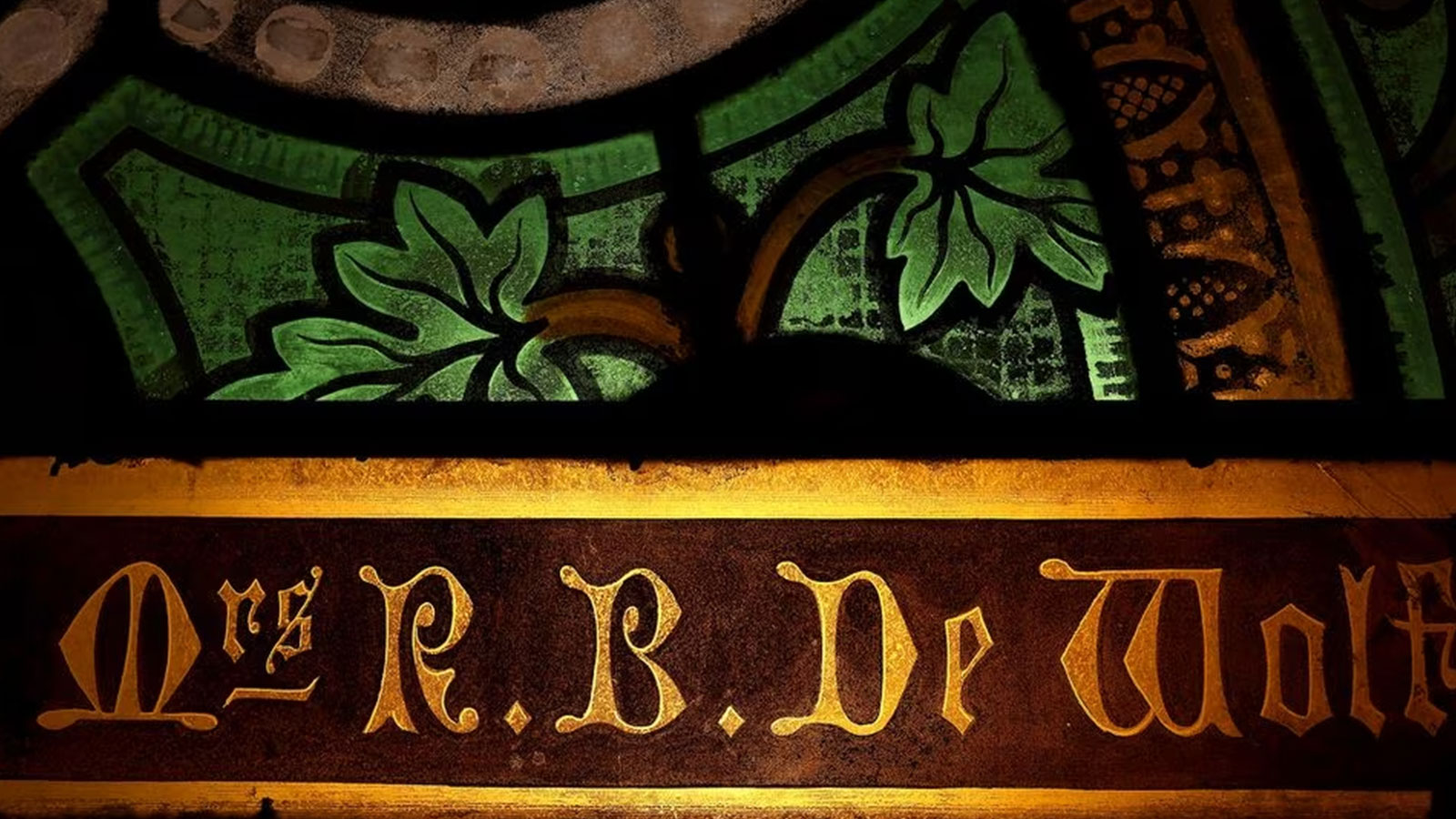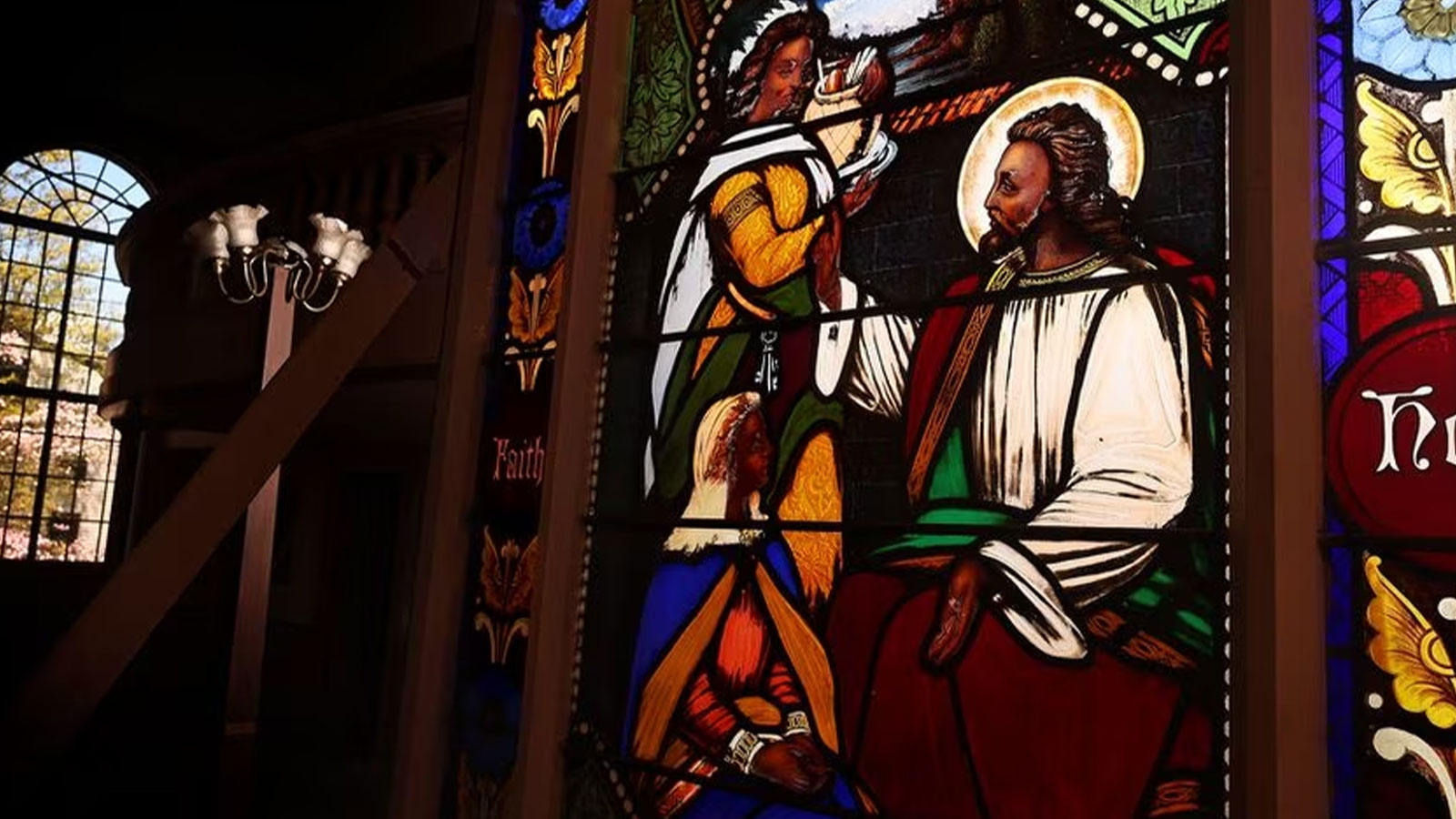Scholars think the window, commissioned in 1877, could be the first of its kind. ‘It should stand as a landmark in American culture,’ says art historian Virginia Raguin.
By Malcolm Gay, Boston Globe —
Clambering up a scaffold, art historian Virginia Raguin quickly realized she was peering at an exceptional window of stained glass, perhaps unique in the history of art.
She had arrived that day last summer at St. Mark’s Church, a decommissioned house of worship in this town’s historic district, to examine the 150-year-old window that shows Christ speaking openly with three Biblical women, an unmistakable commentary on Christ’s humanity and his honoring of both sexes. More radical yet: Each figure in the window is rendered with dark skin, a revolutionary gesture. Some believe it could be the first work of its kind to depict Christ as a person of color — as he almost certainly was.
“I have found no precedent for that,” said Raguin, a stained-glass expert who has written several books on the subject. She added that while there are later depictions of Christ as a Black man, she has not encountered such an image in pre-20th century stained glass in the United States or elsewhere.
“It should stand as a landmark in American culture,” said Raguin, a professor emerita at the College of the Holy Cross in Worcester.

A detail of the window that depicts Jesus with dark skin in a Warren, R.I., church. (Lane Turner/Globe Staff)
But the window, which has since drawn interest from major museums, harbors other mysteries as well: It was commissioned in 1877 by Mary P. Carr to honor her aunts Hannah Bourne Gibbs and Ruth Bourne DeWolf, wealthy white women with complicated ties to slavery.
Not only were members of the Bourne family enslavers, but Ruth also had married into Rhode Island’s DeWolf clan, a hugely-wealthy family that many historians consider the country’s largest slave traders. Meanwhile, researchers have found that Gibbs’s husband captained slave ships, including some owned by the DeWolfs.
Both Gibbs and DeWolf supported the American Colonization Society, a controversial group that sought to send formerly enslaved people to Africa. DeWolf left money in her will to found a church in neighboring Bristol, R.I., intending it to be an egalitarian sanctuary where parishioners wouldn’t have to buy or rent pews — the period custom.
So, did Carr commission the window to honor a pair of women who had quietly advocated for equality despite the source of their considerable wealth? Was the window part of an effort to airbrush their reputations by a guilt-ridden niece? Were they simply being recalled as deeply religious people, with the window designed to honor Biblical teachings of the preciousness of all humanity in the eyes of Christ? Or was Carr’s motive something historians have yet to discover?
A group of researchers is combing through archives to find out.
“We don’t have enough information,” said Catherine Zipf, executive director of the Bristol Historical and Preservation Society. “It’s extraordinary, and I don’t know what to make of it, which is what interests me.”

The former St. Mark’s Church is being converted into a private residence. (Lane Turner/Globe Staff)
Consecrated in 1830, St. Mark’s once boasted four stained-glass windows from the studio of Henry E. Sharp, a well-known glassmaker in New York. The church closed in 2010. It was later purchased by Hadley and Peter Arnold, who are converting the Greek Revival building into a residence.
The windows were at some point outfitted with storm windows that obscured details in the stained glass, but Hadley Arnold said she began puzzling over one of them a few years back, noticing that it seemed different than the rest.
“I don’t think that’s a trick of the eye,” she recalled thinking. “So I got my daughter to come look at it with me, and I said: ‘Am I nuts, or are these Black folks?'”
Her hunch was confirmed last summer, when they finally removed the storm windows in preparation to de-install the stained glass and exchange it with clear replacements. The other Sharp windows featured large, central figures, such as Salvator Mundi, an iconic image of Christ, with flesh rendered in milky white glass.
Sharp’s window for DeWolf and Gibbs, by contrast, presented two narrative scenes with dark-skinned protagonists: In one, Christ speaks with Lazarus’s sisters, Mary and Martha; in another, he speaks with the Samaritan woman.
Raguin believes the scenes are likely based on illustrations from a pair of French and German bibles from the 1860s, adding the window includes numerous other innovations. For instance, both scenes have detailed landscapes, a style she said didn’t come into vogue until several decades later.

The window has been removed and placed on a secure stand. (Lane Turner/Globe Staff)
Then there’s the matter of how Christ is presented in relation to the women, speaking with them on a visual plane that emphasizes equality.
“He is human as well as divine,” said Raguin, who speculated Sharp may have brought in a woman artist to work on the window. “We are his equals, because we are all of us fully human.”
For Arnold, the work’s maverick handling of race should not eclipse that it’s also a “women’s window.”
“There’s a racial dimension, but I cannot tell you how powerful it is to see three women getting the job done in conversation with their God,” said Arnold, who has sent the other stained-glass windows to an architectural salvage firm. “We don’t see that that much.”
She added that she’s been approached by several large museums about acquiring the window, though she declined to name the institutions publicly.
“We have a major responsibility here,” she said. “This needs to make it into the public trust.”
As for the story’s other three women — Carr, DeWolf, and Gibbs — big questions remain.
Carr commissioned the window the same year Republicans agreed to remove federal troops from the South, all but ensuring the end of Reconstruction and ushering in the Jim Crow era of extreme and violent repression of Black people. Raguin said Carr likely instructed Sharp’s firm on which illustrations to use and exactly how she wanted the finished window to look, down to the skin tones.
“That, to me, is the most logical conclusion,” she said, adding that any records Sharp may have kept about the window no longer exist. “I would be totally astonished if anyone in the Sharp studio sat down and drew up this picture.”
Researchers have unearthed scant historical mention of the stained glass, though a parish priest praised the gift soon after it was installed, saying “the peculiar fitness” of the scenes, along with the window’s fine craftsmanship, made it a fitting “expression of those Christian characters in whose memory it has been erected.”
By the time it was installed in 1878, of course, both Gibbs and DeWolf had already died, having lived for decades as widows.

The names of the women honored adorn the bottom of the windows. (Lane Turner/Globe Staff)
Researchers are still trying to piece together biographical information for all three women. But it’s known that DeWolf married her husband, John DeWolf, in 1839, when she was 52 years old and he was 79.
By then, John had already grown wealthy trafficking in enslaved Africans. The DeWolfs are believed to have transported some 11,000 people in bondage over the course of generations, with John, his brother James, and other family members often captaining the boats.
“The rumor about John DeWolf is that he didn’t want to be involved in the slave trade any longer,” said Zipf, who added there isn’t much evidence that Ruth was “an abolitionist.” “The fact of the matter is that he’s up to his neck in it just like everybody else in the DeWolf family.”
John died within a few years of marrying Ruth, who along with her sister frequently donated to the American Colonization Society, a cause supported by numerous northern congregations in the 1800s.
The ACS, which established an African colony that later became Liberia, is estimated to have sent more than 13,000 people to Africa over the course of 50 years. And though abolitionists such as Frederick Douglass denounced it as “mean and impudent in the extreme, for one class of Americans to ask for the removal of another class,” the effort drew support from prominent politicians, including, at one point, Abraham Lincoln.
Joanne Melish, an emerita historian at the University of Kentucky, said she didn’t think the window’s dark-skinned figures were necessarily related to the ACS. She noted that “virtually every northern ordained minister” at the time “supported the American Colonization Society because they believed it was the ‘reasonable’ route to the abolition of (southern) slavery.”
“But of course the ACS was (in the North, anyway) also a vehicle for shipping Black people ‘back to Africa’ (an Africa most of them had no personal experience or knowledge of) in order to ‘restore’ the white republic,” Melish, who’s beenconsulted onthe window, said via email. “This is a complicated and troubling story, and the provenance of the window is caught up in it.”
The picture is further muddled by Ruth DeWolf’s will, which sought to establish the church with free pews.
“This moment speaks quite a bit about Ruth,” said Zipf, who added thatthe window challenges many historical assumptions about race, women, faith, and slavery in Rhode Island.
“This window is speaking to us,” she said. “It’s saying, ‘You’ve got to do a whole lot more homework, people, because this just doesn’t fit what we know.’ ”
Source: Boston Globe
Featured image: A former Warren, R.I., church undergoing renovations to become a private home has yielded a historic discovery: a Reconstruction-era stained glass window that depicts Jesus as a man of color, which researchers think may be without precedent for the period. (Lane Turner/Globe Staff)















